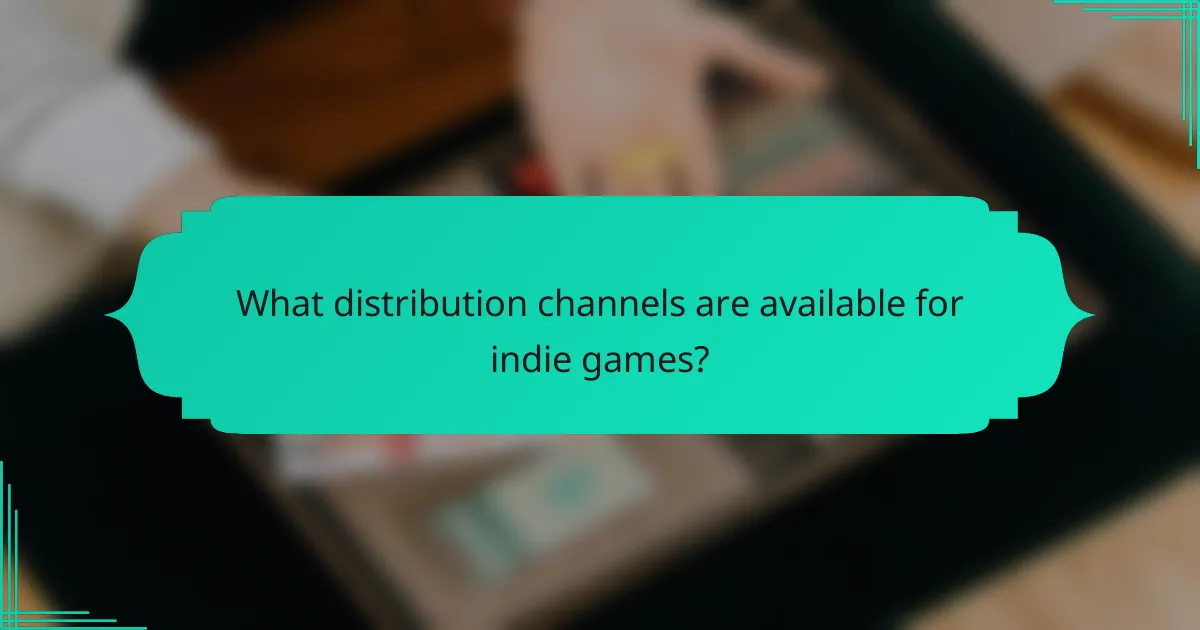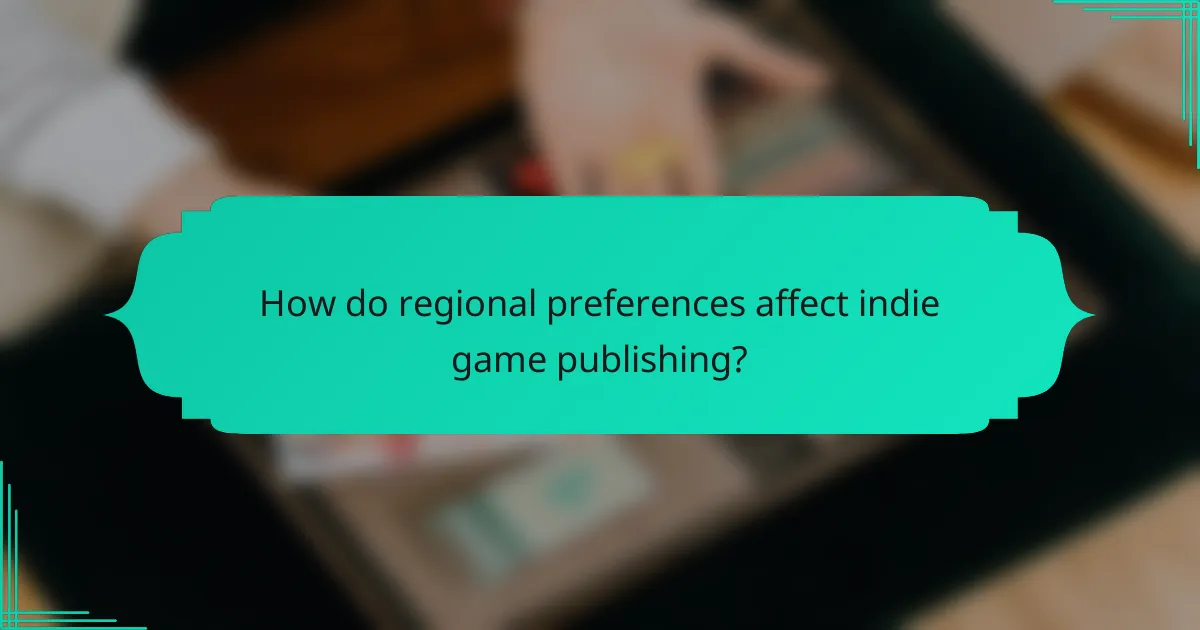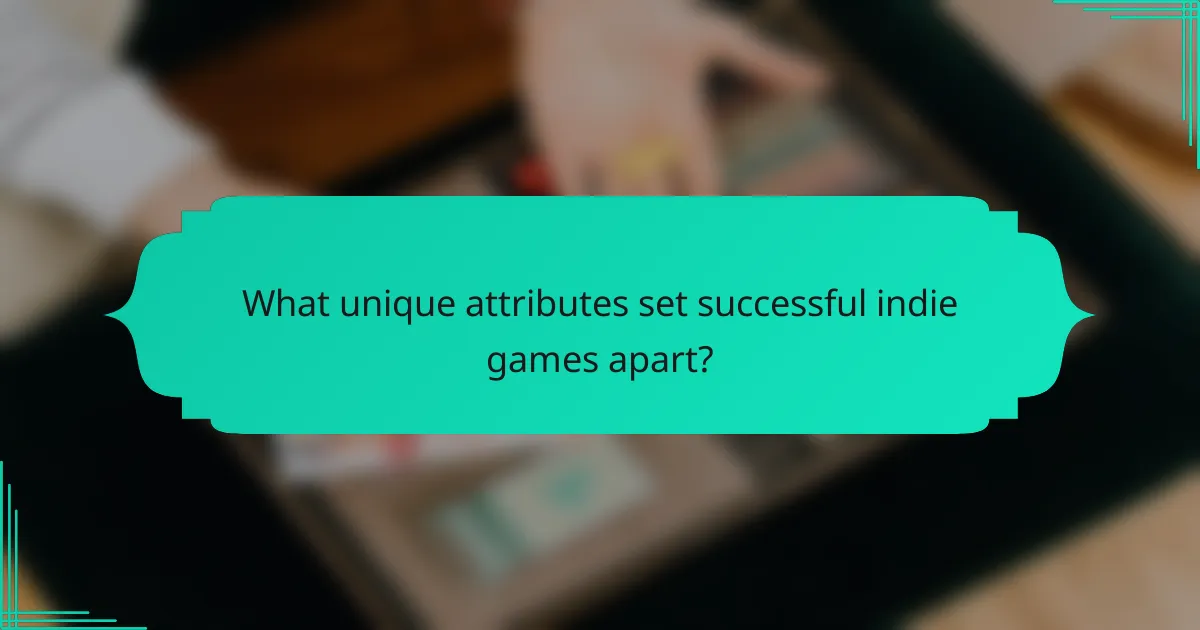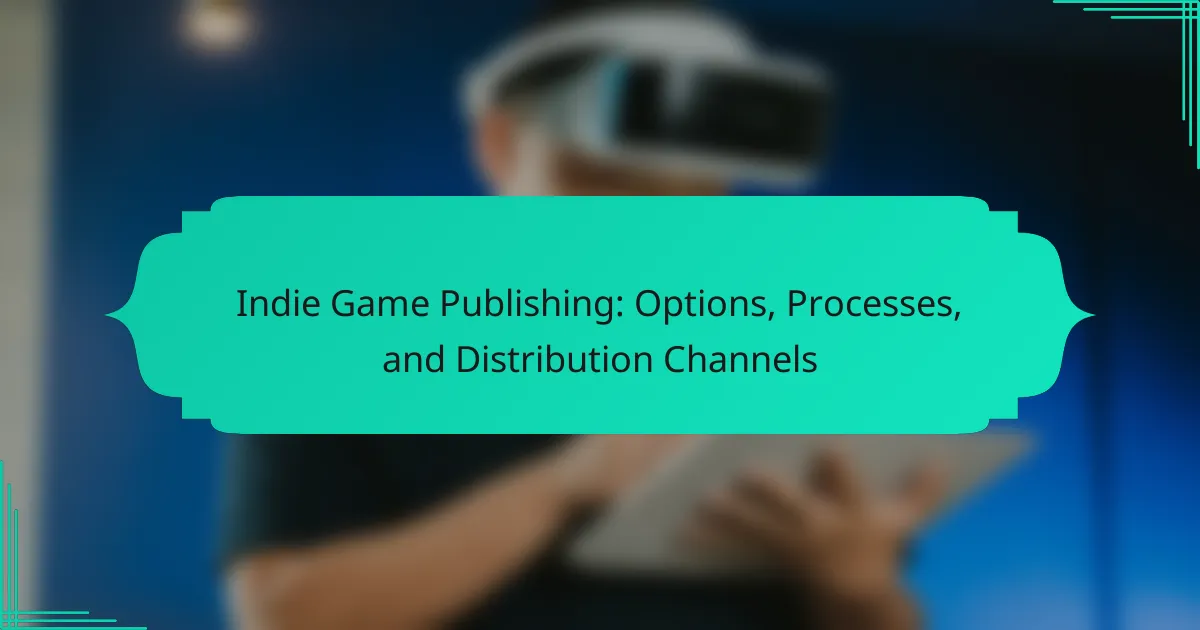Indie game publishing presents various options, processes, and distribution channels that can significantly impact a developer’s success. This article explores self-publishing versus partnering with publishers, outlines essential processes like marketing and distribution, and examines key platforms such as Steam and itch.io. Additionally, it highlights the importance of regional preferences and community engagement in shaping effective publishing strategies.

What are the key options for indie game publishing?
Indie game developers have several key options for publishing their games, including self-publishing, partnering with publishers, and utilizing digital distribution platforms. Each option has distinct processes and benefits.
Self-publishing allows full creative control but requires extensive marketing efforts. Partnering with publishers can provide funding and resources, but may limit creative freedom. Digital distribution platforms like Steam, itch.io, and Epic Games Store offer accessible distribution channels, with varying revenue shares and audience reach.
Ultimately, the choice depends on the developer’s goals, resources, and desired level of involvement in the publishing process.
How do self-publishing and traditional publishing compare?
Self-publishing offers more control and potentially higher profits, while traditional publishing provides established distribution and marketing support. Both have distinct advantages and challenges.
| Aspect | Self-Publishing | Traditional Publishing |
|———————-|————————————-|————————————-|
| Control | High | Low |
| Profit Potential | Higher | Lower |
| Distribution | Direct to consumer | Established networks |
| Marketing Support | Limited, self-driven | Comprehensive, publisher-driven |
| Time to Publish | Faster | Slower, due to processes |
| Creative Freedom | Greater | Often limited by publisher’s vision |
What role do crowdfunding platforms play in indie game publishing?
Crowdfunding platforms are crucial for indie game publishing as they provide financial support and community engagement. These platforms enable developers to secure funding while building a loyal audience. Successful campaigns can validate game concepts and attract further investment. Additionally, crowdfunding fosters direct communication between creators and backers, enhancing trust and collaboration.
Which digital distribution platforms are most popular for indie games?
Steam, itch.io, and Epic Games Store are the most popular digital distribution platforms for indie games. Steam dominates with its vast user base and tools for developers. Itch.io offers a flexible platform for indie creators, allowing for unique pricing models. Epic Games Store provides a competitive revenue split, attracting many indie developers. Each platform has unique attributes, catering to different needs within the indie game community.
How do console publishers differ from PC and mobile platforms?
Console publishers focus on exclusive titles and hardware integration, while PC and mobile platforms emphasize accessibility and diverse distribution. Console publishing often involves partnerships with manufacturers, ensuring optimized performance for specific devices. In contrast, PC and mobile platforms support a broader range of indie games, enabling easier entry for developers. Console games typically undergo rigorous quality control, while PC and mobile titles may prioritize rapid updates and user feedback.

What processes are involved in indie game publishing?
Indie game publishing involves several key processes including development, marketing, distribution, and post-launch support. Developers create the game, followed by strategizing marketing efforts to build an audience. Distribution channels like digital storefronts facilitate game sales. Post-launch support includes updates and community engagement to enhance player experience.
What are the essential steps in preparing a game for release?
To prepare a game for release, follow these essential steps: finalize the game design, conduct thorough testing, create a marketing strategy, choose distribution channels, and launch the game. Each step ensures a successful indie game publishing process.
1. Finalize game design: Polish gameplay mechanics, graphics, and user interface.
2. Conduct thorough testing: Identify and fix bugs through beta testing with real users.
3. Create a marketing strategy: Develop promotional materials and a social media presence.
4. Choose distribution channels: Select platforms like Steam or itch.io for game release.
5. Launch the game: Execute the release plan and monitor feedback for future updates.
How can indie developers effectively market their games?
Indie developers can effectively market their games by leveraging social media, engaging with gaming communities, and utilizing platforms like Steam and itch.io. These channels provide direct access to target audiences and facilitate community building.
They should create compelling trailers and gameplay videos to showcase their games visually. Collaborating with influencers can amplify reach and credibility. Additionally, participating in game festivals and competitions can enhance visibility and networking opportunities.
Email marketing can also be a powerful tool to keep potential players informed about updates and launches. Offering demos or early access can generate buzz and gather valuable feedback.
Finally, maintaining an active online presence through consistent updates and interactions fosters a loyal player base, which is crucial for long-term success.
What are the common pitfalls during the publishing process?
Common pitfalls during the publishing process include inadequate planning, poor marketing strategies, and neglecting quality assurance. Many indie developers underestimate the importance of a solid marketing plan, leading to low visibility. Additionally, skipping thorough testing can result in negative player experiences, harming reputation. Lastly, failing to understand distribution channels can limit reach and sales potential.

What distribution channels are available for indie games?
Indie games can be distributed through various channels including digital storefronts, crowdfunding platforms, and self-publishing websites. Digital storefronts like Steam and itch.io provide broad visibility and user access. Crowdfunding platforms such as Kickstarter allow developers to raise funds while building a community. Self-publishing websites enable direct sales to consumers, offering more control over pricing and marketing. Each channel has unique advantages, catering to different needs and strategies in the indie game publishing landscape.
How do online stores impact indie game visibility?
Online stores significantly enhance indie game visibility by providing broader access to diverse audiences. They serve as platforms for discovery, allowing indie developers to reach potential players who may not find their games otherwise.
These stores often feature user reviews and ratings, which can influence purchasing decisions. The visibility of indie games increases through promotional opportunities, such as discounts and featured listings. As a result, indie developers can build a community around their games, leading to sustained interest and engagement.
Additionally, online stores facilitate direct feedback from players, helping developers refine their offerings. This interaction can lead to unique attribute development, differentiating games in a crowded market. Overall, the impact of online stores on indie game visibility is profound, driving both sales and community growth.
Which physical distribution options exist for indie games?
Indie games can be distributed physically through several options, including retail partnerships, self-publishing, and limited edition releases. Retail partnerships allow indie developers to reach broader audiences via established stores. Self-publishing enables direct sales to consumers, often through conventions or online platforms. Limited edition releases create exclusivity, appealing to collectors and dedicated fans. Each method varies in cost, reach, and impact on brand visibility.
What are the benefits of using subscription services for indie games?
Subscription services for indie games offer several benefits that enhance both player experience and developer visibility. These platforms provide access to a diverse library of games, allowing players to discover unique titles that may not be available through traditional retail channels.
Additionally, subscription models often include regular updates and new releases, keeping the gaming experience fresh and engaging. Developers benefit from increased exposure and a steady revenue stream, which can be crucial for sustaining indie projects.
Moreover, the community aspect of subscription services fosters player interaction and feedback, helping developers refine their games based on real user experiences. This collaborative environment can lead to improved game quality and player satisfaction.
Overall, subscription services create a win-win scenario, promoting indie games while providing gamers with varied and ongoing entertainment options.

How do regional preferences affect indie game publishing?
Regional preferences significantly influence indie game publishing by shaping content, marketing strategies, and distribution channels. Different cultures have unique gaming tastes, which can dictate game design and narrative elements. For example, localization is crucial; adapting language and cultural references enhances player engagement.
Market trends also vary regionally, affecting platforms used for distribution. In some areas, mobile gaming dominates, while others favor PC or console experiences. Understanding these preferences allows indie developers to target their audience effectively, maximizing reach and potential sales.
Furthermore, regional events and gaming communities can provide vital support for indie titles. Participating in local gaming festivals or online forums can enhance visibility and foster connections with potential players and collaborators.
By aligning game development and marketing efforts with regional preferences, indie publishers can create more resonant and successful gaming experiences.
What are the cultural considerations for publishing in different markets?
Cultural considerations for publishing in different markets include understanding local preferences, regulations, and gaming norms. Adapting content to reflect cultural values enhances acceptance and success. Localizing language, imagery, and gameplay mechanics is crucial. Additionally, awareness of regional marketing channels and distribution methods can significantly impact reach and engagement.
How does player behavior vary across regions for indie games?
Player behavior for indie games varies significantly across regions due to cultural preferences and market dynamics. For example, in North America, players often favor narrative-driven experiences, while European players may prioritize innovative gameplay mechanics. In Asia, mobile indie games dominate due to high smartphone penetration. Regional pricing strategies also affect player engagement, with lower prices in emerging markets boosting accessibility. Understanding these behaviors helps indie developers tailor their offerings to meet local demands effectively.

What unique attributes set successful indie games apart?
Successful indie games stand out due to their unique storytelling, innovative gameplay mechanics, and strong community engagement. These attributes foster a distinct player experience and create lasting connections. Engaging narratives often resonate emotionally, while unconventional gameplay can challenge norms. Community involvement through feedback and support strengthens loyalty and visibility.
What innovative marketing strategies have proven effective for indie developers?
Indie developers have found success with innovative marketing strategies like community engagement, influencer partnerships, and targeted social media campaigns. These methods foster a loyal player base and enhance visibility.
Community engagement builds strong connections through forums and social platforms, allowing developers to gather feedback and create a sense of belonging. Influencer partnerships leverage established audiences, providing authentic promotion and reaching potential players effectively. Targeted social media campaigns utilize analytics to reach specific demographics, maximizing marketing impact and resource efficiency.
These strategies highlight the importance of direct interaction and tailored approaches in indie game publishing.
How do storytelling and art style influence indie game success?
Storytelling and art style significantly enhance indie game success by creating emotional connections and unique aesthetics. Compelling narratives engage players, while distinctive visuals attract attention. Together, they foster memorable experiences that encourage word-of-mouth promotion and player loyalty. A strong story can elevate gameplay, while an innovative art style can differentiate a game in a crowded market, leading to increased visibility and sales.

What are the rare attributes that can enhance an indie game’s appeal?
Unique attributes that can enhance an indie game’s appeal include innovative gameplay mechanics, distinctive art styles, and compelling storytelling. These elements create memorable experiences that resonate with players. Additionally, community engagement through player feedback and unique marketing strategies can further differentiate indie games in a competitive market. Emphasizing emotional connections and niche themes can attract dedicated audiences.
How can collaborations with artists or musicians elevate an indie game?
Collaborations with artists or musicians can significantly enhance an indie game by enriching its aesthetic appeal and emotional depth. Unique visual styles and soundtracks can create immersive experiences that attract players. Collaborations often lead to innovative gameplay mechanics, leveraging the artistic talents of musicians and visual artists. Additionally, these partnerships can expand marketing reach, tapping into the fanbases of the collaborators, which increases visibility and potential sales. Engaging artists can also foster a sense of community around the game, encouraging player loyalty and ongoing support.
What impact does community engagement have on indie game longevity?
Community engagement significantly enhances indie game longevity by fostering player loyalty and creating a vibrant player community. Active engagement leads to continuous feedback, which helps developers refine gameplay and address player concerns. This iterative process can result in sustained interest and increased sales over time. Furthermore, community-driven events and updates keep the game relevant, encouraging players to return and attract new audiences. Engaged communities often share content, expanding the game’s visibility and reach.
What are the best practices for optimizing indie game launches?
To optimize indie game launches, focus on strategic marketing, community engagement, and timing. Effective practices include building a strong online presence, utilizing social media platforms, and engaging with gaming communities.
Establish a clear launch plan that outlines goals, target audience, and promotional activities. Collaborate with influencers and streamers to increase visibility.
Leverage platforms like Steam and itch.io for distribution, ensuring the game is well-prepared for submission. Monitor player feedback post-launch to adapt marketing strategies and improve future releases.
Consider using a staggered launch approach to build momentum and maintain interest over time.
